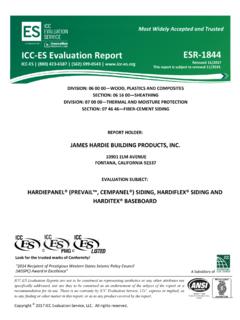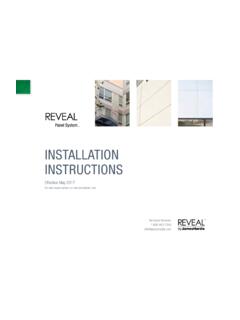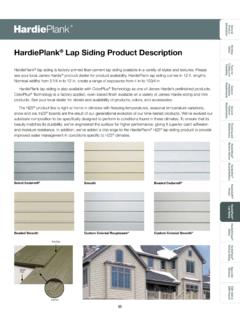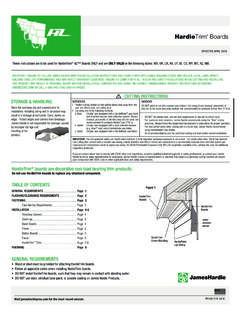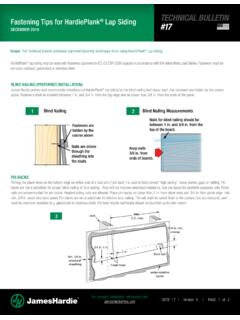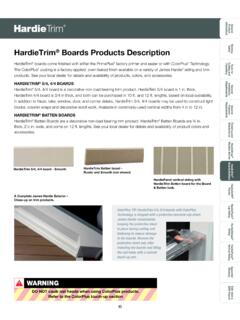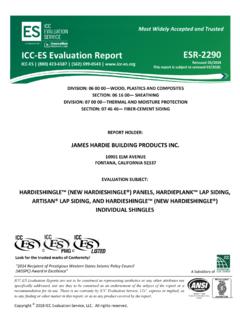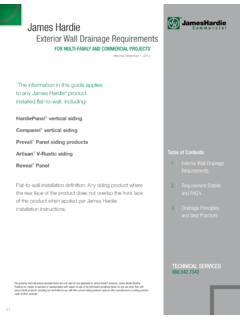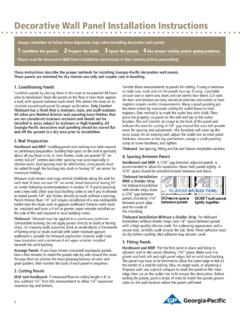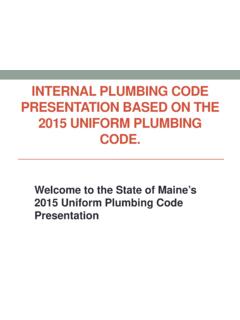Transcription of Installation Guide - James Hardie Pros
1 Installation Guide HardieBacker . Cement Board 500. HardieBacker . Cement Board 1/4 in ESPA OL AL OTRO LADO. CUTTING CEMENT HARDIEBACKER BOARD. U se a straight edge as a Guide to score the board's face and snap upward along the score line. We recommend using a carbide- tipped scoring knife, but a utility knife may also be used. The use of shears (manual, electric or pneumatic) is also acceptable. F or cutouts and small holes, score around perimeter and break out from the face side with hammer. N. EVER use high-speed power tools ( saws, grinders, etc.) to cut James Hardie . products indoors as they may generate excessive silica dust. NEVER dry sweep Use wet dust suppression methods or HEPA vacuum for clean-up. To further limit respirable silica dust exposures, wear a properly-fitted, NIOSH- approved dust mask or respirator ( N-95 dust mask) in accordance with applicable government regulations and manufacturer instructions .
2 COUNTERTOP Installation . 1 | Ensure cabinets are level and secure Use minimum 1/2 in exterior grade plywood or equivalent, positioned across the wood cabinet. Space between plywood supports is not to exceed 16 in on center. 2 | Determine layout of HardieBacker cement board Do not align HardieBacker cement board joints with plywood joints. Score and snap boards to required sizes and make necessary cutouts. We recommend an 1/8 in gap from board edges. 3 | Attach HardieBacker cement board to countertop Apply a supporting bed of dry-set mortar or modified thinset to plywood with a 1/4 in square-notched trowel. Mastic can also be used with a 5/32 in V-notched trowel. Use the fastener pattern as a Guide . Fasten HardieBacker cement board with specified nails or screws (as listed in Materials Required") every 8 in over the entire surface.
3 Keep fasteners between 3/8 in and 3/4 in from board edges and 2. in from board corners. 4 | Tape joints prior to tiling . Prior to setting the tile, fill all joints with the same mortar used to set the tiles. Embed 2 in wide high-strength alkali-resistant glass fiber tape in the mortar and level. 5 | Exterior application (Limited to HardieBacker 500 in HZ10. climate zones) Additional details on page 4. Follow Countertop Installation steps 1 thru 4. Mastic (organic adhesives) shall not be used in exterior applications 1 | English FLOOR Installation . (Interior Application Only). We recommend 1/4 in HardieBacker . board for floor applications, unless 1/2 in thickness is needed for transition. 1 | E nsure subfloor is structurally sound On existing structures: Ensure subfloor is not damaged.
4 Replace any loose, warped, uneven or damaged sections of floor. Make certain subfloor is a clean and flat surface. For all floors: Use minimum 5/8 exterior grade plywood or 23/32 OSB with Exposure 1. classification or better, complying with local building codes and ANSI Joist spacing not to exceed 24 in on center. The floor must be engineered not to exceed the L/360 deflection criteria (L/720. for natural stone), including live and dead design loads, for the specific joist spacing used. 2 | Determine layout of HardieBacker cement board Stagger all HardieBacker cement board joints. Do not align with subfloor joints. Never allow all four corners of boards to meet at one point. We recommend an 1/8 in gap between board edges. Keep sheet edges 1/8 in back from walls and cabinet bases.
5 Score and snap boards to required sizes and make necessary cutouts. 3| A. ttach HardieBacker cement board to subfloor Apply a supporting bed of mortar or modified thinset to subfloor using a 1/4 in square-notched trowel. Embed HardieBacker cement board firmly and evenly in the wet mortar. Use the fastener pattern as a Guide . Fasten HardieBacker cement board with specified nails or screws (as listed in Materials Required ) every 8 in over the entire surface. Keep fasteners between 3/8 in and 3/4 in from board edges and 2 in from board corners. Set fastener heads flush with the surface without overdriving. 4 | Tape joints prior to tiling . Prior to setting the tile, fill all joints with the same mortar used to set the tiles. Embed 2 in wide high-strength alkali-resistant glass fiber tape in the mortar and level.
6 English | 2. WALL Installation . 1 | E nsure framing is structurally sound Must comply with local building codes and ANSI Use a minimum of 2 in x 4 in wood studs or 20-gauge metal studs, which must be straight, properly aligned and spaced a maximum of 16 in on center. In tub and shower enclosures, ensure that the framing is adequately reinforced at the corners. 2 | Determine layout of HardieBacker cement board Boards may be installed vertically or horizontally. Edges of the board parallel to framing must be supported by a structural framing member. Score and snap boards to required sizes and make necessary cutouts. 3 | Attach HardieBacker cement board to framing For interior installations, the use of a waterproof membrane, vapor barrier or vapor retarding membrane is optional unless the local building code requires it.
7 If required by the local building code, install a code compliant waterproof membrane, vapor barrier or vapor retarder membrane, check with the membrane manufacturer for suitability for applicable conditions and follow the manufacturer's Installation instructions for these materials. Install boards 1/4 in above floor, tub or shower pan and caulk accordingly. Fasten cement board with specified nails or screws (as listed in Materials Required ) a maximum of 8 in on center at all supports. Keep fasteners 3/8 in from board edges and 2 in in from sheet corners. Set fastener heads flush with the surface, without overdriving. 4 | Tape joints prior to tiling Fill all joints with mortar (see Materials Required ). Embed 2 in wide high-strength alkali-resistant glass fiber tape in the mortar and level.
8 5 | Exterior application (Limited to HardieBacker 500 in HZ10 climate zones) Additional details on page 4. I nstall HardieBacker 500 over sub-sheathing with a code approved water-resistive barrier, or in accordance with applicable code. M. ay be used up to a height not exceeding the lesser of: through the second-story above grade or 30 feet above grade. Follow wall Installation steps 1 thru 4. 3 | English FINISHING WITH TILE. 1. Refer to ANSI A108 and the mortar and tile manufacturers' published application guidelines for complete tiling instructions . 2. Wipe the surface of HardieBacker . cement board clean with a damp sponge just prior to adding mastic or mortar. 3. Spread the mastic or mortar with a notched trowel (Note: Please see Materials Required to see which setting material is required for your application).
9 4. Twist or press and beat in tiles complying with ANSI 5. Allow a minimum of 24 hours curing set time before grouting. FINISHING WITH NATURAL STONE. Natural stone often has hidden weaknesses which can result in surface cracks in finished floors. To reduce the risk of job failures, always consult The Marble Institute of America Handbook. In addition to the steps outlined under Floor Installation , the following is required: Always follow the recommendations of the flooring material manufacturer. Marble and natural stones must have sufficient flexural strength for use in flooring systems.* Where the quality and strength of the stone is unknown, the floor must be engineered not to exceed the L/720 deflection criteria, including live and dead design loads, for the specific joist spacing used.
10 The strength of your natural stone will have an impact on the ultimate performance of your flooring system. *Testing has shown that a minimum 2900 psi is preferable for flooring application. FINISHING WITH PAINT, WALLPAPER OR TEXTURE. (Interior Application Only). 1 | Painting or Wallpapering Apply a drywall primer suitable for high-moisture areas, as recommended by the paint manufacturer. Paint HardieBacker board as you would drywall. If wallpapering, prime surface of HardieBacker board with a primer suitable for high-moisture areas as recommended by the wallpaper manufacturer. 2 | Texturing Texture can be applied to HardieBacker board in the same way as drywall. STEAM ROOM APPLICATION. HardieBacker board is recognized for use in residential steam rooms when installed over conventional framing and in accordance with HardieBacker board printed Installation instructions , TCNA guidelines (Tile Council of North America Handbook, ), and local building codes.
